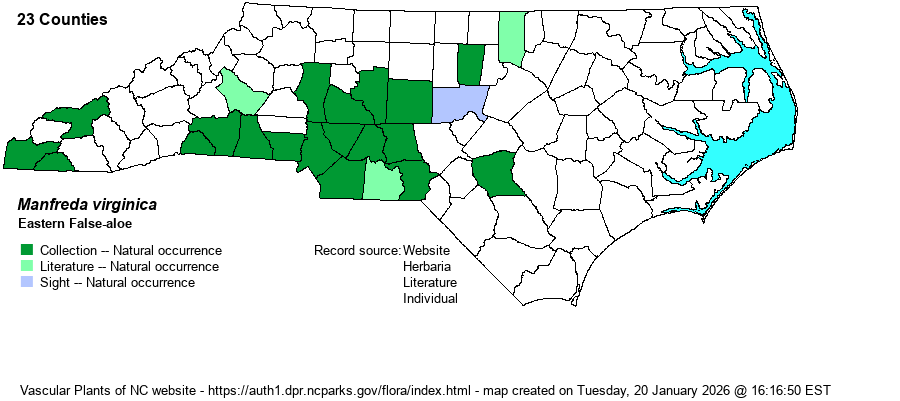| Author | L. | |
| Distribution | Primarily the southern 60% of the Piedmont, as well as the southwestern Mountains, and sparingly into the northeastern Piedmont and at one or two sites in the western Coastal Plain.
This is a Southern species that ranges north to the NC Piedmont, western VA, southern OH, and southern MO southward to northern FL and central TX. | |
| Abundance | Rare to uncommon in the southern 60% of the Piedmont; very rare northeast to Granville County, and east to Cumberland County. Rare in the extreme southwestern Mountains, where known from just three counties. Individual populations are very variable, from just a single plant to >100 in one Anson County population. This is a Watch List species as designated by the NC NHP. | |
| Habitat | This species occurs on dry and very thin soil, typically in rocky places close to a granitic flatrock or other type of rock outcrop. The soil can be acidic or circumneutral. Usually it is found in scattered shade of a glady woodland, barrens, or other unusual woodland with thin and rocky soil. |
| Phenology | Blooms from late May into August; fruits from August into October. | |
| Identification | When in bloom, this is a very striking and unforgettable species, in part owing to its rarity and also to its uniqueness in the state. The species has a basal rosette of long, thick and fleshy, strap-like leaves that grow to about 1 foot long and about 1-2 inches wide; the leaves may have some scattered small serrations and may be somewhat mottled in color. (Note -- in spring or early summer, the leaves may be rather short and widely elliptical, less than 6 inches long.) Sadly, most of the plants do not flower in a given year, but those that do send up a very tall stem to about 4-6 feet high! The top foot of the stem contains many narrow, tubular flowers that are angled strongly upward. The flower is rather greenish, and from the tepals extend very long stamens with conspicuous tan or pale yellow anthers that seem to give the flower a tan or yellowish color rather than green! As the flowers are difficult to describe in print, you should look at photos online to see what a flower and the inflorescence looks like. The flowers are also very fragrant. As this is a scarce species in the state, anytime you run across one or a few of them -- they seldom grow in sizable colonies -- it is a memorable experience. The only species that might be confused with it are yuccas, such as Yucca filamentosa. But inland yuccas have leaves that have filamenous margins, usually with many more leaves in the basal rosette than with Agave. | |
| Taxonomic Comments | This species has been shifted around from one genus to another a few times. RAB (1968) listed it as Agave virginica, but for most of the latter part of the 20th Century and much of the present century it was named as Manfreda virginica. Note that Weakley (2018) has the genus within the Family Agavaceae; RAB (1968) had it in the Family Amaryllidaceae.
| |
| Other Common Name(s) | Eastern Agave, Rattlesnake-Master (also used for one or more other plants), American Aloe, False Aloe | |
| State Rank | S3 | |
| Global Rank | G5 | |
| State Status | W1 | |
| US Status | | |
| USACE-agcp | | |
| USACE-emp | | |

